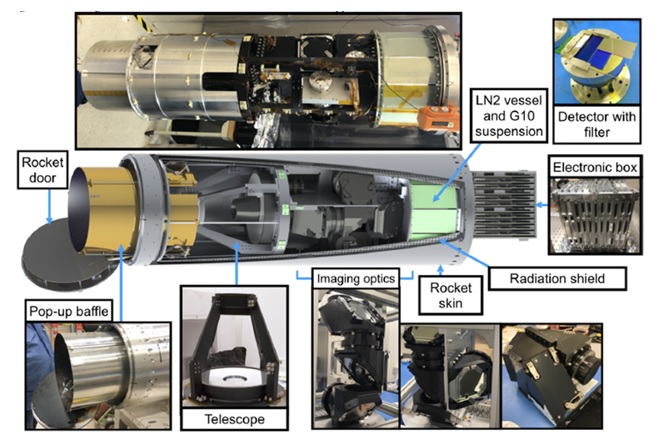松浦周二・理学部教授らの国際研究グループが、NASAのロケットを使い、宇宙赤外線背景放射を観測
Searching for the First Stars: Observing Cosmic Infrared Background Radiation Using NASA Rockets
2021.06.09
共同研究 Collaborative Research
松浦周二・理学部教授(赤外線天文学)の研究室と九州工業大学、東京都市大学、宇宙航空研究開発機構(JAXA)などでつくる国際研究グループは、米国のホワイトサンズ・ミサイル実験場(ニューメキシコ州)から2021年6月7日0時25分(米国山岳部標準時)に打ち上げられた米国航空宇宙局(NASA)のロケットで、初期の天体の解明を目指した観測実験を行いました。2009年から2013年まで計4回の打ち上げで進めたロケット観測実験CIBER(Cosmic Infrared Background ExpeRiment)の成果をふまえた実験で、プロジェクト名は「CIBER-2」。地上の望遠鏡では捉えられない遠くの星について、星々から出る赤外線を合わせた「宇宙赤外線背景放射」の観測から、宇宙で最初に生まれた星や原始ブラックホールなどの宇宙初期天体を調べようというものです。
今回のロケットに載せたのは、CIBER実験の10倍高い感度を得るため新たに開発した反射望遠鏡。地球の大気の影響を受けない高度325㎞まで打ち上げ、落下するまでのうちの約5分間、宇宙背景放射を観測しました。CIBER-2では、CIBERではなし得なかった可視光から近赤外線にかけた多波長でのゆらぎの観測をより高い精度で行っており、今後、宇宙初期天体の痕跡を探すために、取得したデータを解析していきます。
◆NASAホームページ
https://sites.wff.nasa.gov/code810/news/story251-36.281 CIBER 2.html
An international group of researchers, whose membership includes the lab of Professor Shuji Matsuura at the Kwansei Gakuin University School of Science (Infrared Astronomy), the Kyushu Institute of Technology, Tokyo City University, and the Japan Aerospace Exploration Agency (JAXA), conducted an observation experiment using a National Aeronautics and Space Administration (NASA) rocket launched from the White Sands Missile Range (New Mexico, USA) on June 8, with the aim of clarifying early celestial objects (hereafter, objects). Named CIBER-2, the project is based on the results of CIBER (Cosmic Infrared Background ExpeRiment), an observation experiment which the group made progress on via a total of four rocket launches from 2009 to 2013. The purpose of CIBER-2 is to investigate the first stars in the universe, primordial black holes, and other early objects by observing cosmic infrared background radiation, which is a combination of infrared radiation emitted from faraway stars that cannot be captured by ground-based telescopes.
This time, the launched rocket carried a newly developed reflecting telescope, which is ten times more sensitive than what was used in the CIBER experiment. The rocket was launched to an altitude of about 300 km, where it would be unaffected by the Earth's atmosphere, and the researchers observed the cosmic background radiation for about five minutes before it fell. For CIBER-2, they observed fluctuations in multiple wavelengths, from visible light to near-infrared radiation, with a higher degree of precision that was not achieved for the CIBER experiment. In the future, the team will analyze the acquired data to search for traces of early objects.


back
